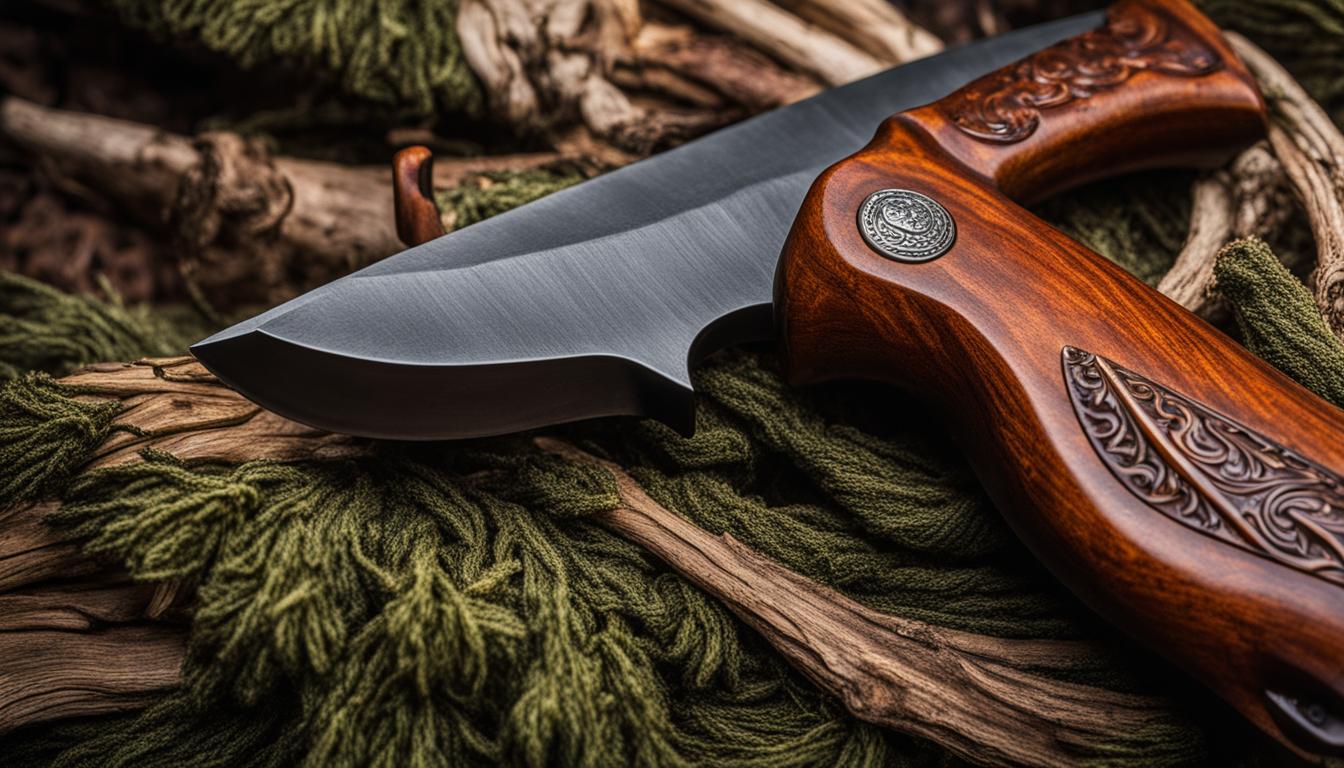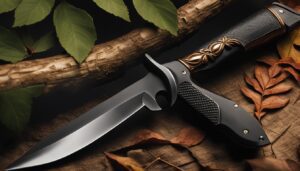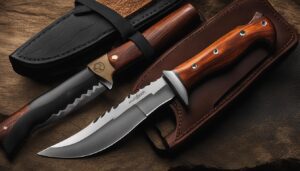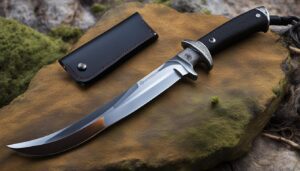When it comes to outdoor adventures, having the right tools can make all the difference. And for those who are passionate about bushcraft and hunting, a reliable bushcraft hunting knife is an absolute must-have. Whether you’re building a fire, preparing food, or engaging in survival tasks, a well-chosen knife can be your most valuable tool.
In this comprehensive guide, I will take you through the key features and materials to consider when choosing the perfect bushcraft hunting knife. From understanding what bushcraft truly is to exploring the different types of steel used in knife blades, I will provide you with all the information you need to make an informed decision.
So, if you’re ready to take your outdoor adventures to the next level and find the perfect hunting knife, let’s dive in!
Key Takeaways:
- Choosing the right bushcraft hunting knife is crucial for outdoor enthusiasts.
- A reliable knife is essential for various bushcraft activities such as fire building, woodwork, and food preparation.
- Consider factors like blade material, handle design, size, weight, and sheath quality when selecting the perfect knife.
- Bushcraft knives and survival knives have some differences in terms of purpose and design.
- By understanding your specific needs and preferences, you can find a high-quality knife that enhances your outdoor experiences.
What is Bushcraft?
Bushcraft is a way of life and a set of wilderness skills that go beyond survival techniques. It is about consciously choosing to live in harmony with nature and learning how to navigate and thrive in the wild. Bushcraft enthusiasts engage in various activities such as using a knife, building a fire, finding and preparing food, and creating shelter. It is a way to reconnect with nature and experience true freedom.
When it comes to outdoor activities, bushcraft offers a unique experience. Unlike other forms of outdoor recreation, which may involve following set paths or relying on modern conveniences, bushcraft takes you back to basics. It teaches you how to adapt and thrive in the natural environment, using simple tools and techniques that have been honed over centuries.
From learning how to identify edible plants to constructing a shelter using natural materials, bushcraft encompasses a wide range of skills that are essential for survival in the wild. It is a way to challenge yourself, gain self-reliance, and develop a deep appreciation for the natural world.
Bushcraft: The Key to Outdoor Adventures
Engaging in bushcraft activities opens up a world of outdoor adventures. It allows you to explore remote wilderness areas, test your skills, and push your limits. Whether you are embarking on a solo expedition or joining a group of like-minded individuals, bushcraft offers a unique and rewarding experience.
With bushcraft, you have the freedom to roam and immerse yourself in the natural environment. It is not just about survival; it is about thriving and enjoying all that nature has to offer. From foraging for wild food to crafting tools from natural materials, each activity adds depth to your outdoor adventures.
So, if you are looking for a way to enhance your outdoor experiences, consider delving into the world of bushcraft. Discover the skills and knowledge that will enable you to venture off the beaten path and create lifelong memories in the great outdoors.
Carbon Steel vs Stainless Steel
When it comes to choosing a bushcraft hunting knife, one of the key decisions you need to make is the type of steel used in the blade. Carbon steel and stainless steel are the two main options available, each with its own set of advantages and disadvantages.
Carbon Steel Knives
Carbon steel knives are renowned for their toughness and ease of sharpening. They are known for their ability to hold a fine edge, making them ideal for tasks that require precision and control. Additionally, carbon steel knives can develop a natural patina over time, which not only adds to their aesthetic appeal but also helps to protect the blade from rust.
However, it is important to note that carbon steel knives are not rust-resistant. They require regular maintenance and care to prevent corrosion. If you choose a carbon steel knife, it is essential to keep it clean and dry after use to avoid any potential damage.
Stainless Steel Knives
In contrast, stainless steel knives are rust-resistant and require less maintenance compared to carbon steel knives. They are highly durable and retain their sharpness for extended periods of time, making them a popular choice for outdoor enthusiasts.
However, stainless steel knives can be more challenging to sharpen compared to carbon steel knives. They are known for being more resistant to wear and tear, which means you might need specialized tools or professional assistance to maintain their sharpness.
Choosing the Right Material
Ultimately, the choice between carbon steel and stainless steel comes down to personal preference and the specific requirements of your outdoor adventures. Consider the level of maintenance you are willing to commit to, as well as your sharpening skills and the conditions in which you will be using the knife. No matter which material you choose, investing in a high-quality bushcraft hunting knife will ensure that you have a reliable tool by your side for all your outdoor endeavors.

| Carbon Steel Knives | Stainless Steel Knives |
|---|---|
| Advantages: | Advantages: |
| • Tough and easy to sharpen | • Rust-resistant |
| • Can develop a natural patina | • Retain sharpness well |
| • Fine edge for precision tasks | • Highly durable |
| • | • |
| Disadvantages: | Disadvantages: |
| • Not rust-resistant | • More difficult to sharpen |
| • Requires regular maintenance | • May require specialized tools for sharpening |
Bushcraft Knife Buying Guide
When it comes to choosing the right bushcraft hunting knife, there are several factors to consider. In this buying guide, I will walk you through the key features that you should pay attention to in order to find the perfect knife for your outdoor adventures.
Intended Use
First and foremost, think about how you plan to use the knife. Are you primarily using it for woodwork, survival tasks, or food preparation? Different activities may require different blade designs. For example, a drop-point blade is versatile and ideal for general outdoor tasks, while a clip-point blade is better suited for precision cutting and piercing. Consider the specific tasks you will be performing and choose a blade shape that matches your needs.
Size and Weight
The size and weight of the knife can greatly impact its usability. A larger knife may be more effective for chopping and cutting tasks, but it can also be bulkier and more cumbersome to carry. On the other hand, a smaller knife may be easier to handle and carry, but it may not be as efficient for heavier tasks. Consider the balance between size and weight that feels comfortable for you and suits your intended use.
Handle Comfort and Grip
The comfort and grip of the handle are important factors to ensure a secure and comfortable hold on the knife. Look for a handle material that provides a good grip, even in wet or slippery conditions. Popular handle materials include wood, rubber, and synthetic materials like G10 or Micarta. It’s also a good idea to check if the handle has ergonomic features that fit well in your hand and prevent discomfort during extended use.
Durable Sheath or Carry System
Lastly, pay attention to the sheath or carry system that comes with the knife. A durable and well-designed sheath will not only protect the blade but also provide easy accessibility when you need to quickly deploy or stow away the knife. Look for a sheath that securely holds the knife and allows for a variety of carry options, such as belt carry or attachment to a backpack or gear.
By considering these factors, you can confidently choose the right bushcraft hunting knife that meets your specific needs. Remember to take into account your intended use, the size and weight of the knife, the comfort and grip of the handle, and the quality of the sheath or carry system. With the perfect knife in hand, you’ll be ready to tackle any outdoor adventure with confidence and precision.
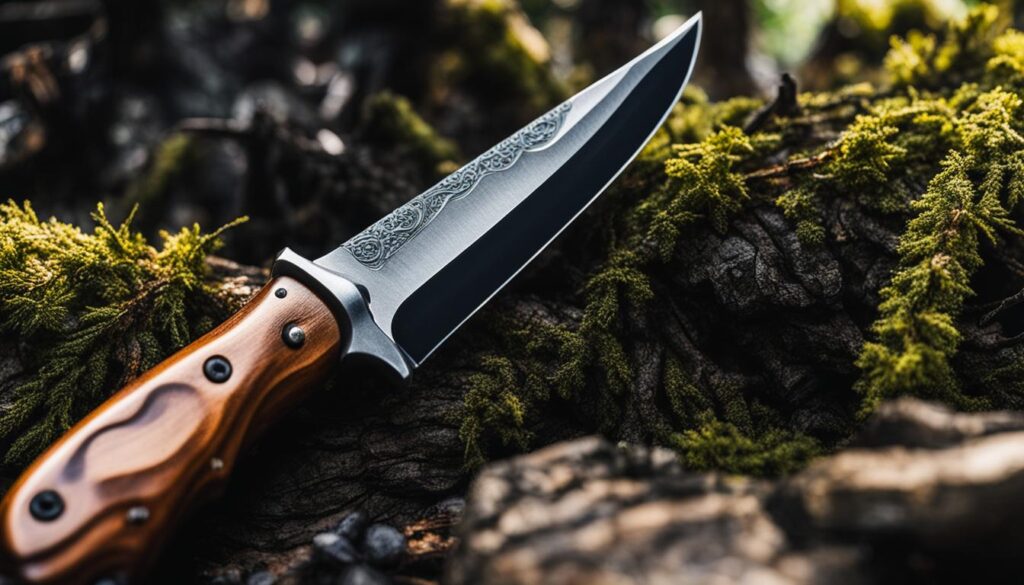

Top Picks for Bushcraft Hunting Knives
When it comes to choosing the perfect bushcraft hunting knife, there are plenty of options out there. To help you narrow down your search, I’ve compiled a list of my top picks for bushcraft hunting knives. These knives have been chosen based on their quality, durability, and performance in the field. Whether you’re an experienced bushcrafter or just starting out, one of these knives is sure to meet your needs.
Mora Companion
The Mora Companion is a classic bushcraft knife that is beloved by outdoor enthusiasts around the world. With its razor-sharp stainless steel blade and ergonomic handle, it’s a reliable tool for any bushcraft task. The Mora Companion is lightweight and easy to handle, making it perfect for intricate woodwork and food preparation. It also comes with a durable sheath for easy storage and accessibility.
ESEE 6
The ESEE 6 is a rugged and dependable knife that can handle any bushcraft challenge. Made from high carbon steel, it offers excellent edge retention and durability. The ESEE 6 features a full tang construction and a comfortable Micarta handle for a secure grip in any weather conditions. Whether you’re batoning wood or building a shelter, the ESEE 6 is up to the task.
Benchmade Bushcrafter
For those seeking the best of the best, the Benchmade Bushcrafter is a top-tier choice. Crafted with premium materials, such as S30V stainless steel and G10 handles, this knife is built to perform in the toughest conditions. The Benchmade Bushcrafter offers exceptional edge retention, corrosion resistance, and ergonomics. It’s a true workhorse that will last a lifetime.
These are just a few of my top picks for bushcraft hunting knives. Each of these knives offers its own unique features and advantages, so take the time to consider your specific needs and preferences. Whether you’re a seasoned bushcrafter or a beginner, investing in a high-quality bushcraft hunting knife is essential for a successful and enjoyable outdoor adventure.
The Difference Between Bushcraft Knives and Survival Knives
When it comes to outdoor activities, having the right tools can make all the difference. Two popular choices for wilderness enthusiasts are bushcraft knives and survival knives. While they may seem similar at first glance, there are some key differences that set them apart.
The Purpose
Bushcraft knives are specifically designed for intentional bushcraft activities. These activities include woodwork, fire building, foraging, and other skills needed to thrive in the wilderness. They are meant to be versatile tools that can handle various tasks encountered during outdoor adventures.
On the other hand, survival knives are geared towards emergency situations. They are designed to help you survive when things go wrong and you find yourself in a life-threatening scenario. Survival knives prioritize functionality and durability above all else.
The Design
Bushcraft knives tend to have a lighter weight and a more friendly appearance. They are often smaller in size, with a fixed blade and a comfortable handle that allows for precision cutting and carving. These knives are built to be used for extended periods of time without causing fatigue.
Survival knives, on the other hand, are typically heavier and larger in size. They often feature a full-tang construction and a thick blade, which makes them stronger and more suitable for heavy-duty tasks like chopping wood or prying. The design of survival knives prioritizes strength and durability over comfort.
The Versatility
While bushcraft knives are versatile and can handle a wide range of tasks, survival knives are even more versatile. Survival knives are designed to be multi-functional tools that can be used for hunting, self-defense, building shelters, and more. They are built to handle the unexpected challenges that may arise in a survival situation.
In conclusion, while bushcraft knives and survival knives have overlapping features, their purposes, designs, and versatility set them apart. Whether you’re embarking on a bushcraft adventure or preparing for potential emergencies, understanding the differences between these two types of knives will help you make the right choice for your outdoor needs.
Conclusion
Choosing the perfect bushcraft hunting knife is crucial for any outdoor adventure. By considering the specific activities you will be engaged in, the materials used in the knife, and the overall design and functionality, you can find the ideal tool to enhance your bushcraft experience.
When selecting a bushcraft hunting knife, remember to assess your intended use. Whether you need it for woodwork, survival tasks, or food preparation, different blade and handle designs may be required. Additionally, consider the size, weight, comfort, and grip of the knife to ensure it suits your needs.
By exploring the top picks mentioned in this guide, you can discover high-quality bushcraft hunting knives that are recommended for their reliability and performance. With the right knife in hand, you can confidently embark on your next outdoor adventure, knowing that you have chosen the perfect bushcraft hunting knife to accompany you.
FAQ
What is bushcraft?
Bushcraft is a way of life and a set of wilderness skills that go beyond survival techniques. It is about consciously choosing to live in harmony with nature and learning how to navigate and thrive in the wild.
What are the key features to consider when choosing a bushcraft hunting knife?
When choosing a bushcraft hunting knife, it is important to consider the type of steel used, the intended use of the knife, the size and weight, the comfort and grip of the handle, and the durability of the sheath or carry system.
What are the different types of steel used in bushcraft knives?
There are three main types of steel used in bushcraft knives: carbon steel, stainless steel, and tool steel. Each has its own pros and cons in terms of toughness, rust resistance, and sharpening ease.
What is the difference between bushcraft knives and survival knives?
Bushcraft knives are primarily used for intentional bushcraft activities such as woodwork, fire building, and foraging. Survival knives are more versatile and can be used in emergency situations. Bushcraft knives are typically lighter and have a friendlier appearance, while survival knives prioritize functionality and durability.
How do I choose the right bushcraft hunting knife for my needs?
Consider the specific activities you will be engaged in, the materials used in the knife, and the overall design and functionality. By selecting a high-quality knife that meets your needs, you can ensure a successful and enjoyable bushcraft experience.
